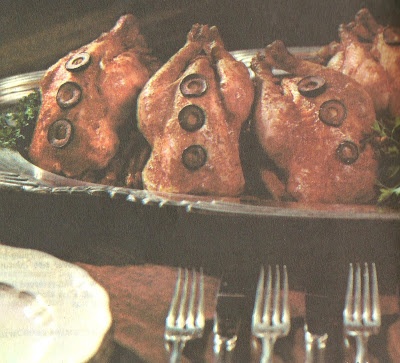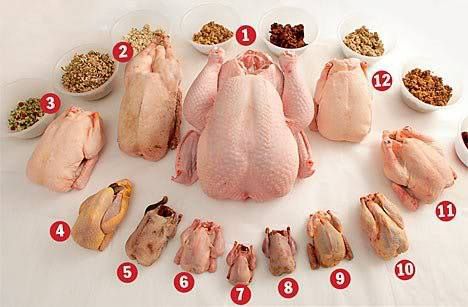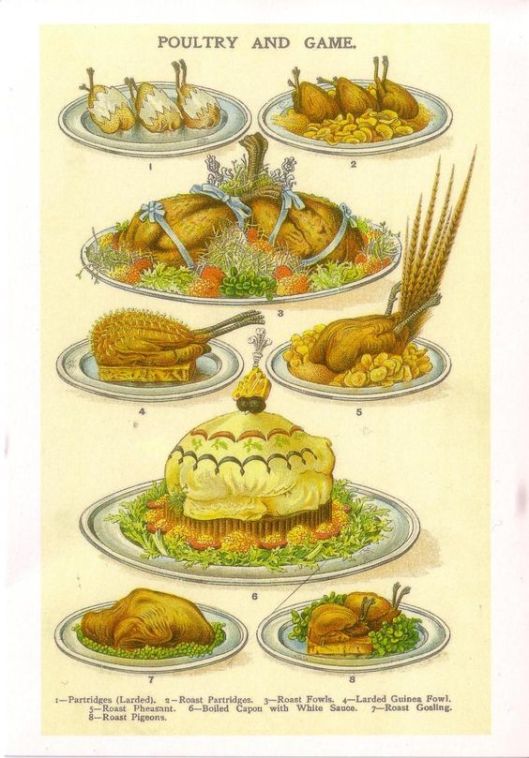This piece picks up where part I left off with part I. Now that we’ve established how the dovecot housed the pigeons who raised the squab that goes on our dinner tables, how was it prepared?

[McCall’s Fish and Fowl cookbook, 1974]
“The blue house-pigeon is the variety principally reared for the table in this country, and is produced from our farmyards in great numbers. When young, and still fed by their parents, they are most preferable for the table, and are called squabs; under six months they are denominated squeakers, and at six months they begin to breed. Their flesh is accounted savoury, delicate, and stimulating, and the dark-coloured birds are considered to have the highest flavor, whilst the light are esteemed to have the more delicate flesh”.
That delicate flesh was prepared in a myriad of ways, 18th century cookery books can contain some 20 different receipts for preparing it. Clermont and others from the early 19th century used the same receipts: White Fricassee of Pigeon, Fricassee of Pigeons with Green Peas, Fricasee of Pigeons, country fashion, Pigeons Masqueraded, Pigeons of a fine bright Colour, Pigeons stuffed with Pistachio Nuts, Pigeons au Court Bouillon, Pigeons a la Sainte Menehoult, Pigeons Glazed and served with Stewed Greens, Pigeons Perigord, Pigeons au Cingara, Roasted Pigeons with different Sauces and Ragouts, Pigeons with Basil, Hodgepodge of Pigeons Spanish Style, Pigeons in Cowl Pontiff Sauce, Pigeons with Craw-fish Cullis, (this had notes regarding au Gratin, and Pigeon Parmesan as well), Pigeons a la Bry with Italian Sauce, Pigeons with Cream and Craw-fish as a Fricassee, Pigeons with Craw-fish Butter, Pigeons accompanied with Craw-fish, Pigeons in a delightful Manner, Pigeons Royal Fashion, Pigeons Masked with Ravigotte Sauce, Pigeons with Cream Sauce, Pigeons glazed or with Parmesan Cheese, Pigeons a la Fiane, Pigeons as if Alive with Fricandeaux, Brown Pigeons, Pigeons the Clergyman’s Fashion, Pigeons in a Hurry, Pigeons with a Ragout, Pigeons with Marrow, Pigeons Provence Fashion, Pigeons like Hedge-hogs, Pigeons the Comptroller’s Manner, Pigeons in Cowl with Onions, Pigeons like a Toad, Flatted Pigeons, Pigeons the Princess’s Fashion (because of their preparation), Stewed Pigeon with blood, Pigeons dobed with or without Fennel, Pigeons the Cardinal’s Fashion, Pigeons the German Fashion, Pigeons farced with Shallots, Matlot of Pigeons, Pigeons of a Game Flavour in Moulds or in Paste, Pigeons masked with Cauliflowers, and Pigeons with Truffels.

Photo credit: Backyard Chickens website. 1. Turkey, 2. Goose, 3. Barbary Duck (Muscovy), 4. Guinea fowl, 5. Mallard, 6. Poussin, (Cornish Rock Game hen/baby cornish X), 7. Quail, 8. Partridge, 9. Pigeon squab, 10. Pheasant, 11. Chicken, 12. Aylesbury duck (pekin)
Pigeon eggs are edible but due to their diminutive size were used more for garnish than substance, often boiled pigeon egg yolks were served in soups. Descriptions of Chinese meals, whether served in China or the U.S. often included pigeon eggs.

[Source: Beeton’s Book of Household Management. #8 is roasted pigeons.]
PIGEONS. Boil the pigeons by themselves for a quarter of an hour; with a proper quantity of bacon cut square, laid in the middle of the dish. Stew some spinach, and lay the pigeons on the spinach. Garnish with parsley dried crisp before the fire. [1831]
CONSOMME COLONBINE. Prepare a good tablespoonful of carrot pearls and one of turnip pearls, keeping the latter very white. Cook them in the ordinary way, and put them in the soup-tureen with one tablespoonful of very green peas, one tablespoonful of a julienne of roast pigeon fillets, and six poached pigeons’ eggs, which latter should be sent to the table in a timbale at the same time as the consommé. Pour over the other garnish one quart of very clear boiling consommé and serve at once. This soup can only appear on menus when pigeon’s eggs are in season. [1912]
SOUP WITH PIGEONS AND POACHED EGGS. Truss the pigeons as for a pie, and half fill them with forcemeat, having plenty of forced mushrooms pounded in it. Scald and drain them dry; and put them in a stew-pan with a pint of veal broth. Stew till done; then make hot two quarts of veal broth, and add to it some carrots, turnips, peeled button onions, and celery heads in lengths of two inches. Steam the vegetables separately before putting them into the broth. Season with salt and make it boil; and five minutes before serving add the pigeons, and a liaison of four poached eggs in the tureen. [1836]
STEWED PIGEON. 6 pigeons, a few slices of bacon, 3 oz. of butter, 2 tablespoonfuls of minced parsley, sufficient stock…to cover the pigeons, thickening of butter and flour, 1 tablespoonful of mushroom ketchup, 1 tablespoonful of port wine. . .Mince the livers and add these to the parsley and butter, and put it into the insides of the birds. Truss them with the legs inward, and put them into a stewpan, with a few slices of bacon placed under and over them; add the stock, and stew gently for rather more than ½ hour. Dish the pigeons, strain the gravy, thicken it with butter and flour, add the ketchup and port wine, give one boil, pour over the pigeons and serve. . .Seasonable from April to September. Sarah J. Hale advised using the same liver mixture to stuff pigeons for roasting [1857]
PIGEON PYE. Your crust must be good, and force [stuff] your Pigeons with good Force-meat; then lay some at the Bottom of your Crust, and your Pigeons a Top; lay your Giblets between with some hard Eggs; Asparagus Tops, Coxcombs and Sweetbreads; put a piece of Butter on top of your Pigeons, and a little Liquor, [broth] so lid and bake it; put in a little Gravy and Butter when you open it. [1732] Note: When butchering, I have saved rooster combs and cooked them for period recipes, however, I found it more for garnish than for adding anything substantial to the dish.
PIGEONS COMPOTE. Skewer six young pigeons in the same manner as for boiling, put forcemeat into the craws, lard them down the breast, and fry them brown. Put them into strong brown gravy, and when they have stewed three quarters of an hour, thicken it with a lump of butter rolled in flour. Make your forcemeat in this manner. Grate the crumbs of half a penny loaf, and scrape a quarter of a pound of fat bacon, which will answer the purpose better than suet. Chop a little parsley and thyme, two shallots, or an onion, some lemon-peel, and a little nutmeg grated; season them with pepper and salt, and mix them up with eggs. When you serve them up, strain your gravy over them, and lay forcemeat balls around them. [1785]
PIGEON PIE. 1 ½ lb. of rump-steak, 2 or 3 pigeons, 3 slices of ham, pepper and salt to taste, 2 oz. of butter, 4 eggs, puff crust. Cut the steak into pieces about 3 inches square, and with it line the bottom of a pie-dish, seasoning it well with pepper and salt. Clean the pigeons, rub them with pepper and salt inside and out, and put into the body of each rather more than ½ oz. of butter; lay them on the steak, and a piece of ham on each pigeon. Add the yolks of 4 eggs, and half fill the dish with stock; place a border of puff paste round the edge of the dish, put on the cover, and ornament it in any way that may be preferred. Clean three of the feet, and place them in a hole made in the crust at the top; this shows what kind of pie it is. Glaze the crust,–that is to say, brush it over with the yolk of an egg,–and bake it in a well-heated oven for about 1 ¼ hour. When liked, a seasoning of pounded mace may be added.
Louis Eustache Ude’s version of pigeon pie was very similar, published in 1815.
BRAISED PIGEONS. Draw [clean] and wash three young pigeons, wipe them well and stuff them with breadcrumbs that have been well seasoned and moistened with warmed butter, and cook them in a brasing pan. Boil some spinach, chop it well, and season with salt and pepper. Toast three slices of bread, lay them on a hot dish, spread the spinach over them, put a pigeon on each slice, and serve with a sauceboatful of gravy.
FRICASSEED PIGEONS. . . . Cut them into pieces, and put them in a saucepan; pour in one pint each of claret and water, and a blade of mace, one onion, a bunch of sweet herbs, a little pepper and salt and one and one-half tablespoonfuls of butter that has been kneaded with a little flour. Cover the pan, and cook slowly for three-fourths of an hour. Remove the pieces of pigeons onto a hot dish, and keep them warm. Strain the gravy, and stir in with it the yolks of three eggs; when thick pour it over the meat, and put some fried oysters on top. Garnish round with croutons of fried bread, and serve.
PIGEONS IN A HOLE. . . stick their legs in their bellies as you do for boiling, and season them with pepper, salt, and beaten mace. Put a lump of butter, of the size of a walnut, into the belly of each pigeon, and lay them in a pie dish. Pour over them a batter made of three eggs, two spoonfuls of flour, and half a pint of good milk. Bake them in a moderate oven, and send them up in the same dish to table. [1806]
I leave you now, gentle reader, with visions of pies, fricassees, roasts, and all manner of good dishes, and, as always, Blissful Meals. © All Rights Reserved.

You must be logged in to post a comment.